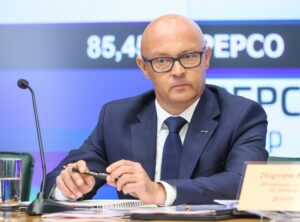A journalists’ visit to Lubmin where the Nord Stream pipeline ends its journey from Russia and reaches Germany, was an opportunity to discuss the purpose of the controversial Nord Stream 2 project. Additionally, we also heard a new, environmentally friendly narrative employed by the proponents of the Russian gas pipeline, writes Wojciech Jakóbik, BiznesAlert.pl’s editor in chief.
Through the courtesy of the Nord Stream management and thanks to the initiative of Clean Energy Wire, journalists from all over Europe had an opportunity to visit the Nord Stream installation in the coastal town of Lubim near Greifswald. Unfortunately, for security reasons the Polish gas transmission system operator, Gaz-System did not agree for the journalists to visit the LNG terminal in Świnoujście. The visit in Poland was supposed to familiarize the press with a different perspective on the gas sector that the one presented by Russia and Germany.
For the same reasons, the Nord Stream management denied the request to take pictures in Lubim. Instead the journalists received memory sticks with pictures taken by the installation’s employees, which made some guests concerned about the security of their private data should they plug the drive into their laptops.
Nord Stream’s spokesman, Jens Muller, presented the basic information on Nord Stream 1. As a reminder – the gas pipeline runs from Russia to Germany across the Baltic Sea. Its annual capacity is 55 bcm. Russians want to add a new line next to it. The Nord Stream documents describe it as a 'new gas pipeline’, which is significant for legal reasons. When the project was first promoted, Russia tried to convince Europe that it was about a new line added to the old pipeline.
This would be relevant for legal interpretation, because the first Nord Stream was not encompassed by the Third Energy Package and a heated debate is taking place in Brussels on the second pipe. In the spokesman’s opinion it had been already decided that the underwater section of Nord Stream 2 should not be subject to EU regulations. However, this is not true and the issue will be determined by the European Council in autumn, when it will decide whether the EC will receive a negotiation mandate to talk with Russia on how to apply the EU law to the new investment. The talks may delay the project, which has been confirmed in a revealing letter to the EC by operators from Austria, Belgium, the Czech Republic and Germany who want to profit from Nord Stream 2.
According to Muller, the dispute about the new pipeline’s legal status did not delay the project at all. When answering my question on whether he shared the concerns of the mentioned operators, he replied such a possibility did not exist. The operators fear that the negotiations between the EC and Russia may cause Denmark to stop the process of Nord Stream 2 environmental impact assessment and wait for the results of the talks, which may end in a few months, or a few years. Jens Muller ensured that the company expected to finalize the obligatory consultations on the project in Denmark in October. He stressed that the project was in progress and that related contracts to the tune of EUR 4 billion had been already signed.
He dismissed questions about the sanctions proposed by the US Senate by saying that as a rule his company did not comment on legislative processes in other countries. At the same time he warned that this would be a precedent, which could impact other gas pipelines, e.g. in Kazakhstan. When asked about the future of transmissions via the Yamal gas pipeline after Nord Stream 2 is opened at the end of 2019, he replied that a certain volume of gas will be still transported via the old route, but the volume would depend on Yamal’s market competitiveness. „Nobody will be forced to use 100% of Nord Stream’s 2 capacity,” he argued. The spokesman assessed that similarly to Yamal’s most splendid years, the optimal usage of the new pipeline to Germany was at 86-90% of its capacity.
Muller tried to dismiss the concerns of Polish journalists about Nord Stream’s 2 impact on the security of gas supply to Central and Eastern Europe by arguing that gas diversification in Europe had been completed. In his opinion, everything worked well at the European level and gas could be imported from any source, currently determined by the price. „The debate on the dependence on Russian gas is a little outdated,” he said. According to him, when gas, e.g. from Russia arrives at the European market it loses its nationality and flows freely to suppliers. He reminded that Europe had the capacity to buy 216 bcm of LNG annually, which means 55-60% of supply to the continent could be covered with liquefied gas, but it was not the case. Obviously this was because of the price. „Currently Russian gas is the cheapest in Europe,” he ensured.
While in the case of Western Europe one can surely talk about a developed gas market where price is the deciding factor, diversification has not been completed in Central and Eastern Europe yet, and Nord Stream 2 may stop it. Spokesman Muller did not want to talk about this at all. The critics of the pipeline from Russia argue that an additional 55 bcm of gas a year will flow from Germany to the Czech Republic and then to the entire region, stabilizing Gazprom’s position and shattering the profitability of diversification projects co-financed by the European Commission, such as the LNG terminal in Świnoujście or the planned Baltic Pipe, which will transmit gas from Norway.
A new element in the case for Nord Stream 2 was an environmental argument against LNG from the United States. The supporters of Russian gas deliveries consider the US gas competition, but they are convinced the Russian fuel is more attractive. Apart from the old arguments, which say that the transportation cost makes US LNG less cost-effective, which has been disproved by the spot deliveries to Poland and Lithuania in June this year, an argument related to climate policy cropped up.
According to the Nord Stream consortium, the carbon footprint of the Russian gas is four times lower than that of the US LNG. Why? Because the US gas is extracted through fracking, which is harmful to the environment. This point won the hearts of Western Europeans who are afraid of greenhouse gas emissions caused by shale gas extraction in their countries. This is how the allies of Russian gas use environmental arguments to defend investments questioned on the political plane in the European Union. The pushing of the environmental agenda is also visible in the actions taken by the Nord Stream 2 consortium. When I published a picture of a train model, which transported pipes for Nord Stream, the consortium of the twin project informed me that it had a more environmentally friendly, less carbon intensive fleet.
The visit in Lubim did not bring the two sides of the Nord Stream 2 dispute any closer. Still, it revealed the logic of its proponents and enriched the debate with environmental arguments. This is a message to the critics of the project, e.g. in Poland. In the future, arguments related to climate policy may be used to defend Nord Stream 2 and criticize alternative projects, such as the LNG terminal in Świnoujście and the initiative of increasing LNG deliveries from the US pursued by the Polish government. It may also be used against the Baltic Pipe, which has to fulfill the highest environmental standards to avoid attacks by environmentalists armed with arguments that have already entered the discussion on diversification.
The openness of the Nord Stream consortium to the visit from journalists allowed it to promote its case for the project. Poles did not use the opportunity to present their own agenda. Still, the good news is that the Polish Ministry of Foreign Affairs sent its representative to a closed discussion on, among others, Nord Stream 2, which allowed the media from all over Europe to learn about the Polish point of view.








